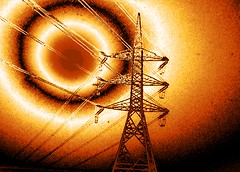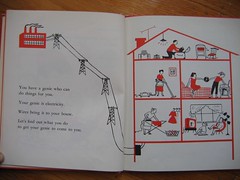(10 am. – promoted by ek hornbeck)
That might as well be the title of the  Wall Street Journal article Surprise Drop in Power Use Delivers Jolt to Utilities.
Wall Street Journal article Surprise Drop in Power Use Delivers Jolt to Utilities.
An unexpected drop in U.S. electricity consumption has utility companies worried that the trend isn’t a byproduct of the economic downturn, and could reflect a permanent shift in consumption that will require sweeping change in their industry.
OH NO!!!! Americans using less electricity and this might be something permanent rather than simply a lousy economy.
Now, as for the ‘lousy economy’, as we have yet to hit bottom and have a long way to go, hard to assert (yet) that it is not economic distress that is driving reduced energy use. Perhaps people are ‘turning off lights’ to save pennies in the face of economic distress. And, patterns begun in economic turmoil could become life’s new patterns. Thus, unlike what the WSJ‘s coverage might suggest, there is much to hope for as to a start in a shifting of American culture toward more energy efficient patterns.
Most utilities plan around an assumption of rather constant and predictable electricity-demand growth curves. This provides “certainty” of planning for generating facilities and other capital investment. Introducing energy conservation and energy efficiency into the equation can threaten these plans.
This provides “certainty” of planning for generating facilities and other capital investment. Introducing energy conservation and energy efficiency into the equation can threaten these plans.
Households are considered “the most stable group of consumers,” thus drops in household demand executive attention.
Dick Kelly, chief executive of Xcel Energy Inc., Minneapolis, says his company, which has utilities in Colorado and Minnesota, saw home-energy use drop 3% in the period from August through September, “the first time in 40 years I’ve seen a decline in sales” to homes.
No, it isn’t foreclosures according to Kelly. Three percent drop in one year: that could be simply through the introduction of CFLs. And, let us be clear, Obama’s green stimulus package could drive these reductions across the broader society.
It isn’t isolated to Xcel Energy.
Duke Energy Corp.’s third-quarter electricity sales were down 5.9% in the Midwest from the year earlier, including a 9% drop among residential customers. At its utilities operating in the Carolinas, sales were down 4.3% for the three-month period ending Sept. 30 from a year earlier.
American Electric Power Co., which owns utilities operating in 11 states, saw total electricity consumption drop 3.3% in the same period from the prior year. Among residential customers, the drop was 7.2%. However, milder weather played a role.
There is a debate in the industry as to the driving factor: ‘simply’ a bad economy or, again, a fundamental change. If we are to have hopes in relation to Global Warming, we should hope that it is the second, that people are learning, changing, and applying that learning to help solve real problems.
Again, there is a real problem here for the WSJ.
Michael Morris, the chief executive of AEP, one of the country’s largest utilities, says he thinks the industry should to be wary about breaking ground on expensive new projects. “The message is: be cautious about what you build because you may not have the demand” to justify the expense, he says.
Conservation and efficiency are not good for expanision plans.
Contemplating implications …
This Wall Street Journal article simply doesn’t mention any non-expansion planning implications, looking at this issue from a very narrow (not unimportant, but narrow) perspective. Here are some additional elements to consider:
Improving Energy Efficiency. The #1 near-term answer, across  the entire economy, to our energy and environmental challenges is reducing inefficiences (waste) in energy use both through changed behavior (‘conservation’) and introduction of energy saving technologies/designs. This is both to ‘turn out the lights’ when not using them and changing the lights from incandescents to compact-fluorescent bulbs. These are ‘negawatts’. Quite roughly, electricity delivered to the customer in the United States costs about 9.5 cents per kilowatt hour (KwH). Study after study, real-world effort after real-world effort highlights that energy efficiency can cut demand by 20+% at prices just a fraction of that (with a wide-range of opportunities if priced at, let us say, 4 cents per KwH). Could the reduction that utilities be seeing be a leading edge indicator of both changed behavior and energy efficiency penetrating into the general public and general use?
the entire economy, to our energy and environmental challenges is reducing inefficiences (waste) in energy use both through changed behavior (‘conservation’) and introduction of energy saving technologies/designs. This is both to ‘turn out the lights’ when not using them and changing the lights from incandescents to compact-fluorescent bulbs. These are ‘negawatts’. Quite roughly, electricity delivered to the customer in the United States costs about 9.5 cents per kilowatt hour (KwH). Study after study, real-world effort after real-world effort highlights that energy efficiency can cut demand by 20+% at prices just a fraction of that (with a wide-range of opportunities if priced at, let us say, 4 cents per KwH). Could the reduction that utilities be seeing be a leading edge indicator of both changed behavior and energy efficiency penetrating into the general public and general use?
What about clean investment? Within the utilities’ plans (or some of them) for increasing electricity power production capacity are clean (solar, wind, geothermal, etc) facilities. Will reduced demand (not slowing inflation of demand, but actual demand destruction) drive down the investment in these clean energy sources? Honestly, hopefully not, and hopefully the regulatory environment will drive greater investment and deployment of clean energy sources so that, in combination with energy efficiency, coal plants can begin to be shut down and shuttered.
What will happen with focused leadership? These reductions have occurred amid economic malaise and generalized discussion of global warming/energy issues/reduction of waste. While the Republicans dismissed (actually, ‘dissed’) President-Elect Obama’s discussion of energy efficiency during the campaign (especially related to inflating tires as a path to reduce gasoline use, and therefore cost, immediately), perhaps this sort of message (from Obama, state and local politicians, prominent figures, religious leaders, etc) has taken root with enough of the population to begin to impact aggregate levels of energy use. What might happen if, as seems likely at this time, President Obama takes the bully pulpit to encourage all Americans to pursue “energy efficiency in your lives, homes, and businesses”? Will the reductions this article discusses simply be a bow wave of massive reductions in the coming few years? What does this say about the ability to eliminate coal from our electrical grid?
Global Warming implications. This article doesn’t point out that the 50% of American electricity coming from coal (and, to a lesser extent, the 22% coming from natural gas) are the largest single contributor to US GHG emissions. (As well as mercury and other pollution.) Cutting into US electrical demand, with the ‘non-produced’ (shut off) power principally from coal-fired plants, is one of the paths toward significant near-term reversal of growing US GHG emissions.
Thus, perhaps the most interesting things from this article, beyond the facts of reduced household electrical use, are not what it discusses but what it doesn’t discuss.
We can all
help make America
Energy Smart.Ask yourself:
Are you doing
your part to
ENERGIZE AMERICA?
NOTES
* Related material at Get Energy Smart! NOW!!!.
* Consider joining the Daily Kos Environmentalists community / listserve.

15 comments
Skip to comment form
thank you!!
Best way to judo corporate America is to hit it in the wallet. Anything to freak out the establishment. 😉
Those new habits are sticking. Same with the electricity bills that started showing up under $150 oil. Change over to low energy bulbs and keep them off. Throw on a blanket and turn down the thermostat.
If milliwatt here and a millwatt there and pretyy soon you’re talking big savings. Might just not need those coal furnaces in the national parks after all.
That is what they call us. Unashamedly, the electric utility providers call us, collectively, we are known as “rate payers”. They say it right in front of me, it’s not like they’re using the ‘n’ word or something… they don’t see it as something to hide from me, it’s not something the marketing department urges them to keep to “inside” meetings.
I do business with the bastards, I talk to them regularly.
In my neck, I pay $0.12/kwh, because that is the ‘rate’ they charge, and I am a ‘rate payer’.
Coincidently (or not) it would cost me about $0.15 per kWh to make my own power using diesel at $2 per gallon. This does not include the cost to purchase a generator, transfer switch, pad, and install it all, so I pay the bastards their “rate” and turn off lights, turn down the thermostat before leaving for work, use curly light bulbs, and generally conserve as best I can.
High energy users pay a “demand rate”, based on their peak demand. (Could be one day in August, they pay for it all 364 of the rest of the days in a year) The justification for this charge is that the utility was required to build enough into the infrastructure to deliver that peak.
No where has anyone ever showed me that users are reimbursed for the inconvenience of unplanned outages, which is the opposite of a demand charge, right?
OK – I’ve established how much I hate the utility as an evil entity I have not been able to divorce myself from.
That said, I’m not feeling any pity for an industry that can no longer count on the “rate payers” to deliver them their expected annual financial windfall.
Boo Hoo!! Cry me an unpolluted river downstream of your enormous smokestack. This essay makes me want to double my efforts to conserve.
That is so interesting. I suspect the reason for the lower use has to do with an increased awareness of global warming and our energy use, as well as an increased need to economize.
BTW, just received this video from I-Sky. It’s quite good.
1Sky’s Gillian Caldwell on the 2008 election and climate change
I convinced my company [retail stores, operate during ‘normal business day’, 9-6] to shut off it’s computer workstations, rather than run them 24/7/365. It was quite a fight, as management had to be convinced that ‘conventional wisdom’ that powering up a computer causes damage is false.
The build of heat running a machine 24/7 is much more damaging to today’s computers than cycling the power.
Spread the word to your company, too.
Of course, it doesn’t have much impact on peak demand, since the resource is used during the day, but it’s better than letting them sit there and suck up power for no reason at all. Saves the company $$$, and they like that part.
————
We also changed our who house over to CFLs, and our electricity bill dropped by nearly 40%.
strange schism in our economy. Wall street seems to be place their bets on the worlds downfall. Betting on greed no matter what the consequence of their short term profits. They should not be wagging the tail, it’s as backwards.